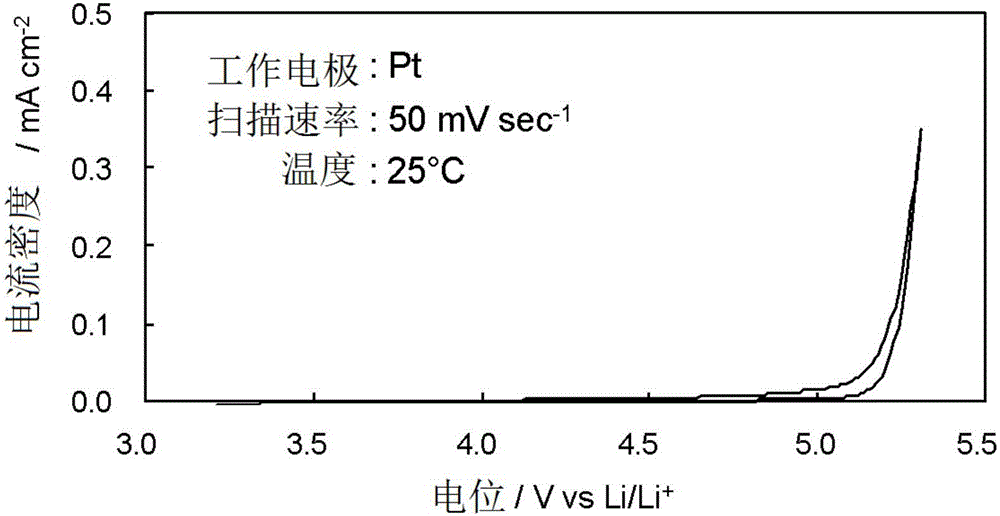Ionic liquid and plastic crystal
An ionic liquid and viscous technology, which is applied in the direction of structural parts, active material electrodes, electrochemical generators, etc., can solve problems such as stability problems, achieve good storage efficiency, suppress the need for cooling, and achieve high efficiency.
- Summary
- Abstract
- Description
- Claims
- Application Information
AI Technical Summary
Problems solved by technology
Method used
Image
Examples
manufacture example 1
[0082] Production Example 1: Anion (f 3 C) Synthesis
[0083] As a commercially available product, 58.4 mg of compound (2) obtained from ALCATRAZ CHEMICALS (Gujarat, INDIA) and 194 mg of SF 4 The reaction gave 51.6 mg of compound (3). 92.4 mg of compound (3) was reacted with excess potassium carbonate and introduced into 93.9 mg of f 3 Potassium salt of C anion (4).
Embodiment 1
[0085] Make the f obtained in Manufacturing Example 1 3 Potassium salt of C anion (4) with equimolar [EMI] + 、[DEME] + 、[Py 13 ] + or [PP 13 ] + The bromide reacts and carries out cation exchange, thus obtains the ionic liquid of the present invention ([EMI][f 3 C]) or viscous crystals ([DEME][f 3 C], [Py 13 ][f 3 C] or [PP 13 ][f 3 C]).
[0086] The physical property values of the obtained ionic liquids or viscous crystals are shown below. In addition, the melting point, glass transition temperature, and solid-solid phase transition temperature are shown in Table 1.
[0087] 1)[EMI][f 3 C]
[0088] 1 H-NMR (CD 3 CN,300MHz):δ=1.45(t,J=7.2Hz,3H),3.81(s,3H),4.16(q,J=7.2Hz,2H),7.32(s,1H),7.37(s,1H ),8.39(s,1H): 19 F-NMR (CD 3 CN,283MHz):δ=71.5(s,3F).
[0089] Elemental analysis measured value (theoretical value): H 2.99% (2.98%); C 22.71% (22.58%); N 7.58% (7.52%); F 15.36% (15.31%). The ion conductivity at 25°C: 6.2 mS cm -1 .Viscosity at 25°C: 39mPa.s.De...
Embodiment 2
[0100] Make the f obtained in Manufacturing Example 1 3 Potassium salt of C anion (4) and equimolar [N 6111 ] + , [N 6222 ] + , [N 1111 ] + , [N 2222 ] + 、[Py 12 ] + , [C 4 mim] + , [C 6 mim] + The bromide reacts and carries out cation exchange, thus obtains the [N of the ionic liquid of the present invention as the target 6111 ][f 3 C], [N 6222 ] + [f 3 C], [N 1111 ][f 3 C], [N 2222 ][f 3 C], [PP 14 ][f 3 C], [Py 12 ][f 3 C], [Py 14 ][f 3 C], [C 1 mim][f 3 C], [C 4 mim][f 3 C], [C 6 mim][f 3 C]. The physical property values of the obtained ionic liquids or viscous crystals are shown below. In addition, the melting point, glass transition temperature, and solid-solid phase transition temperature are shown in Table 1.
[0101] 1)[N 1111 ][f 3 C],
[0102] 1 H NMR (DMSO-d6, 300MHz): δ=3.06(s, 12H); 19 F NMR (DMSO-d6, 283MHz): δ = 71.9 (s, 3F). Thermal decomposition temperature (when reduced by 10%): 348°C.
[0103] 2)[N 2222 ][f 3 C],...
PUM
| Property | Measurement | Unit |
|---|---|---|
| melting point | aaaaa | aaaaa |
Abstract
Description
Claims
Application Information
 Login to View More
Login to View More - R&D
- Intellectual Property
- Life Sciences
- Materials
- Tech Scout
- Unparalleled Data Quality
- Higher Quality Content
- 60% Fewer Hallucinations
Browse by: Latest US Patents, China's latest patents, Technical Efficacy Thesaurus, Application Domain, Technology Topic, Popular Technical Reports.
© 2025 PatSnap. All rights reserved.Legal|Privacy policy|Modern Slavery Act Transparency Statement|Sitemap|About US| Contact US: help@patsnap.com



